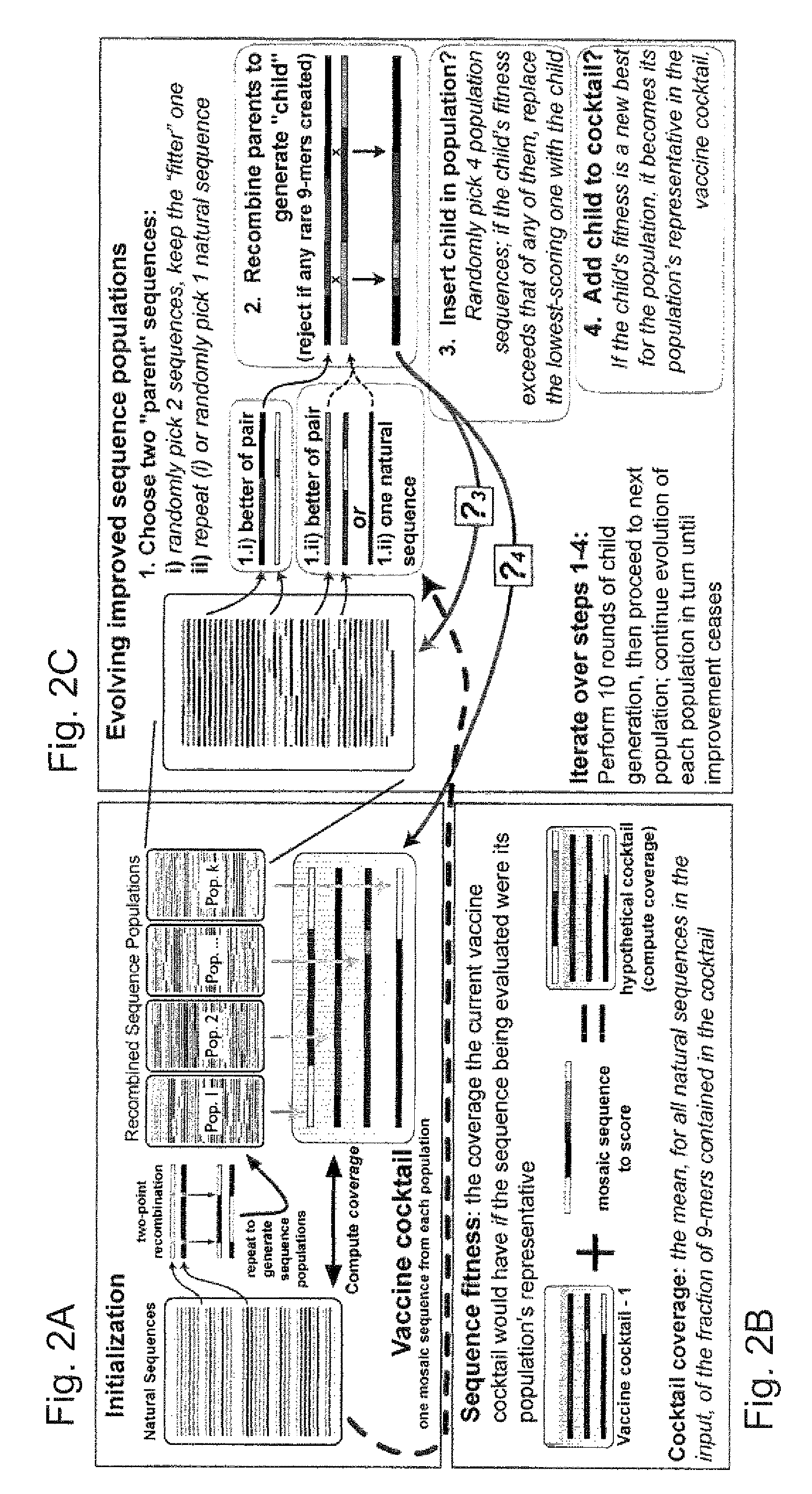Mosaic clade M human immunodeficiency virus type 1 (HIV-1) envelope immunogens
a human immunodeficiency virus type 1 and envelope immunogen technology, applied in the field of polyvalent immunogenic composition, can solve the problems of limited response potential to any single vaccine antigen, limited coverage, and variability
- Summary
- Abstract
- Description
- Claims
- Application Information
AI Technical Summary
Benefits of technology
Problems solved by technology
Method used
Image
Examples
example 1
Experimental Details
[0057]HIV-1 sequence data. The reference alignments from the 2005 HIV sequence database (URL: hiv-dot-lanl-dot-gov), which contain one sequence per person, were used, supplemented by additional recently available C subtype Gag and Nef sequences from Durban, South Africa (GenBank accession numbers AY856956-AY857186) (Kiepiela et al, Nature 432:769-75 (2004)). This set contained 551 Gag and 1,131 Nef M group sequences from throughout the globe; recombinant sequences were included as well as pure subtype sequences for exploring M group diversity. The subsets of these alignments that contained 18 A, 102 B, 228 C, and 6 G subtype (Gag), and 62 A, 454 B, 284 C, and 13 G subtype sequences (Net) sequences were used for within- and between-single-clade optimizations and comparisons.
[0058]The genetic algorithm. GAs are computational analogues of biological processes (evolution, populations, selection, recombination) used to find solutions to problems that are difficult to ...
example 2
[0078]Group M consensus envelope and trivalent mosaic envelopes (both of which were designed by in silico modeling and are predicted to be superior than wildtype envelopes) will be compared to a monovalent wild-type envelope and trivalent wild-type transmitted envelopes in a 4 arm immunogenicity clinical trial. The mosaic antigens have been designed based on the current Los Alamos database, a set that includes more full length envelopes sampled globally from more than 2000 individuals with a large set of sequences of transmitted viruses primarily from the CHAVI database.
[0079]The selection of the natural strains to be used for the comparison is based on the following criteria: For the monovalent natural antigen, use will be made of the single transmitted virus that is the best choice in terms of providing coverage of potential T cell epitopes in the global database. The database is biased towards B dade envelopes, so the single best acute Env is a B clade representative. One A, one ...
example 3
[0145]Construction of the plasmid DNA vaccines and recombinant vaccinia (rVV). Mosaic gag and nefgenes, group M consensus gag and nef genes were generated by converting amino acid sequences of said Gag and Nef, group M consensus Gag and Nef CON-S to nucleotide sequences using a strategy for optimal gene expression. For use as a DNA vaccine, mosaic gag and nef genes, group M consensus gag and nef genes were subcloned into WLV0001-AM DNA vaccine vector. Endotoxin-free plasmid DNA preparation were produced by Puresyn, Inc. (Malvern, Pa.) for the immunization of rhesus monkeys. For boosting recombinant vaccinia viruses expressing the individual mosaic gag and nef genes, group M consensus gag and nefgenes were generated. The methods used were as previously described (Liao et al, Virology 353:268-282 (2006); Earl, BioTechniques 23:1094-1097 (1997)).
[0146]Experimental groups and vaccination schedule. Three groups of rhesus monkeys were immunized with either 10 mg of the empty DNA vector pl...
PUM
| Property | Measurement | Unit |
|---|---|---|
| immunogenic composition | aaaaa | aaaaa |
| cross-reactivity | aaaaa | aaaaa |
| lengths | aaaaa | aaaaa |
Abstract
Description
Claims
Application Information
 Login to View More
Login to View More - R&D
- Intellectual Property
- Life Sciences
- Materials
- Tech Scout
- Unparalleled Data Quality
- Higher Quality Content
- 60% Fewer Hallucinations
Browse by: Latest US Patents, China's latest patents, Technical Efficacy Thesaurus, Application Domain, Technology Topic, Popular Technical Reports.
© 2025 PatSnap. All rights reserved.Legal|Privacy policy|Modern Slavery Act Transparency Statement|Sitemap|About US| Contact US: help@patsnap.com



